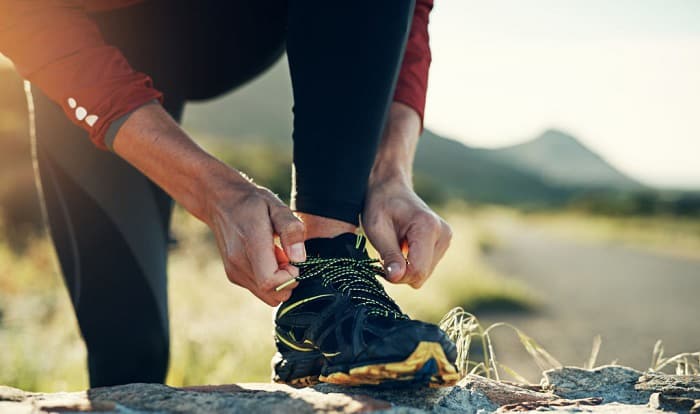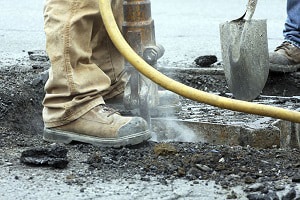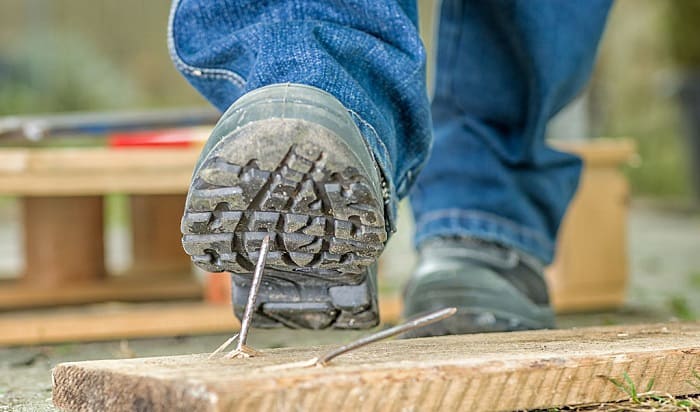Oftentimes we only care about the trendy look a pair of shoes can offer. But it is their protection properties that we should pay close attention to. You might be surprised at how manufacturers curate the tiny details to maximize a shoe’s protection level.
So what type of footwear that protects your entire foot? It depends on the occasions you wear it. For everyday shoes, sneakers and clogs can provide enough protection. For playing sports, it’s best to buy shoes that are typically designed for your activity. For instance, running shoes for running, cross trainers for fitness sessions.
Most importantly, if you are buying boots for work, they must be safe enough for your job. Some common protective features of safety footwear are slip-resistant, cut-resistant, insulated, waterproof, chemical-resistant, toe caps, shanks, and anti-electric shock. Follow our guideline to pick the most suitable footwear that will protect your entire foot.
Table of Contents
Types of Protective Footwear for Different Occasions
Not all shoes can protect your feet. In each particular situation, you need different types of shoes for optimal safety, especially those who work at hazardous worksites. Also, injuries can happen while playing sports or carrying out daily activities.
Casual wear shoes
You won’t need much protection for daily usage. But for optimal safety, it’s best to choose footwear that covers your entire foot like sneakers or clogs.
For people who walk and run for long distances every day. For example, walking to the bus stop and back, walking around university campus, working all-around jobs like waiter and waitress. Make sure the footwear you use has:
- Proper fit: The toe box is wide enough for your toes to wiggle freely. The width fits snugly. You should not experience heel slippage in your daily shoes.
- Good materials: The shoes should be made from firm and durable materials, but soft enough for your feet.
- Non-slip outsoles: When shoes cause slips, you must either get rid of them or get them fixed. Don’t wear slippery Many casual footwear features slip-proof outsoles. If you walk long distances every day, it’s worth investing in good soles.
Sport footwear
Athletic activities bring many benefits to our life. But wearing the wrong shoes when training can cause ingrown toenails, foot strain, or even more serious symptoms like heel spur, plantar fasciitis, and ankle sprain.
Don’t just put on your daily sneakers for fitness sessions. Instead, look for shoes designed for each specific sport activity. Cross trainers are a good choice for training sessions.
Regular shoes won’t provide the right support and protection your feet need when doing athletic activities. Plus, the shoes will wear out quickly. Whatever types of sport footwear you choose, make sure they are made from nice materials and fit properly for optimal protection and comfort.
Harsh working environment
This is when you need protective footwear the most. In fact, the OSHA (the Occupational Safety & Health Administration) makes it mandatory to wear safety boots at certain worksites.
The types of work boots you need to protect the entire foot depend on your working conditions. If you work closely with electricity sources, electrical hazard rated boots are needed. Or if you run chainsaws regularly, cut-resistant boots will protect your feet. Each work has specialized shoes, but they all have some common features to protect the entire foot.
- They are made from strong and protective materials, such as leather, synthetic leather, and suede.
- The soles are sturdy and hard, from resilient materials like rubber.
- They are at least 6-inch tall and cover the ankle bone.
Types of Safety Work Boots to Prevent Common Foot Injuries
Under harsh working conditions, many things can go wrong.
Heavy falling and rolling objects
This usually happens at factories and warehouses where goods are stored in sky-high storage. Or simply at construction sites where builders work with bricks, heavy stones. As long as your job involves heavy objects, there are chances that your feet are injured by falling and rolling object hazards.
Footwear that protects your entire foot in this scenario is safety toe or metatarsal shoes.
- Safety toe boots: These are also known as toe cap boots. Basically, they are work boots with a protective reinforcement inserted in the toe box. It is to prevent the toes from suffering when impact or compression happens. The protective reinforcement can be made from steel, alloy, or composite materials. Among these, steel provides the highest protection while alloy and composite are more on the comfort side.
- Metatarsal shoes: As implied in the name, these come with a metal reinforcement that extends from the tip of the toes to the metatarsals. For those unfamiliar with the term, you can feel five bones extending from the five toes on the upper part of the foot. Those five bones are called metatarsals. This safety footwear type can be the complete boots you need to protect the entire foot.
However, metatarsal shoes are not as comfortable as steel-capped ones. The metatarsal guards can be bulky and unpleasant to the feet.
Punctures
At commercial sites, sharp objects might be left here and there. Don’t underestimate injuries from punctures, they can cause wounds that are beyond recovery. Many people think a hard rubber outsole is enough to prevent sharp object penetrations. That is not the case.
To maximize protection, manufacturers have invented a reinforcement called boot shank. It is a piece of steel inserted in the middle of a boot’s sole. Similar to a toe cap, a shank can be made from steel or composite materials. It is almost impossible to penetrate a steel shank. This feature can protect the bottom of the foot from most injuries.
Cutting hazards
Working with running chainsaws, cutters, or spikers puts you at risk of cutting hazards. The good news is a pair of cut-resistant or chainsaw safety boots will protect your entire foot. Cut-resistant raw materials are usually full grain leather, hybrid knitting, flying woven, and KPU fabrics. They are highly strong and resilient.
For a pair of boots to be cut-resistant rated, they must pass the F1414 test of ASTM International. The test shows the protective level of material against chainsaws and machine tools. The ASTM holds a variety of standards for cut-resistant materials. Some of them are only for when a material is exposed to a sharp cutting edge or make contact with a sharp tool, not running chainsaws or machines. For loggers, make sure your boots are up to the F1414 standard, not other numbers.
Watch this video on Chainsaw boots comparison for excellent recommendations.
Electricity
Electric shock can be fatal. If you work around live wires, please wear electrical hazards (or EH) rated boots. Similar to cut-resistant boots, a pair of safety footwear can only be EH rated when they meet the standards of ASTM International.
For EH-rated boots to protect your entire foot, the upper part and the sole must be from leather and rubber. If the boots come with a steel toe cap or shank, the protective reinforcements must be covered with insulated materials.
Slips and trips
Slips and trips can happen almost at every worksite, especially on slippery surfaces of oil rigs or humid terrain. In that case, you should wear boots that feature slip-resistant soles. Not every rubber sole can be slip-resistant though. These soles are typically designed with certain patterns (some brands make the pattern look like car type grip) to enhance gripping to the ground.
If you climb ladders and trees, choose slip-resistant boots that have raised heels. Heeled boots will ensure ample grip on every step on the ladder.
Chemicals
It’s best for people whose job involves chemical handling to wear chemical-resistant boots. Don’t be naive to think thick boots can protect you from chemicals. Harsh chemicals like caustic soda, nitric acid, and sulphuric acid can easily penetrate thick boots and injure your foot.
Chemical-resistant boots usually feature nitrile outsoles, Kevlar (a fiber thread that is five times stronger than steel) stitching, and leather upper parts.
Cold weather and moisture
Last but not least, jobs like an offshore oil rig and snow shoveling workers require insulated and waterproof safety boots. These boots are to keep your feet warm and dry.
Conclusion
Safety should never be taken lightly. In fact, it should be prioritized. Sacrificing a little comfort for more protection is sometimes necessary. There are many different types of safety boots on the market. Each type is specifically designed for specific jobs. Take your time to learn about their properties to maximize your own safety.
We hope you’ve gathered enough information on what type of footwear that protects your entire foot. It’s our pleasure to have your attention. Feel free to let us know if you have further questions. See you next time!

Veronica is our content editor. She is a talent in delivery. Her main work is editing and writing articles that are both informative and simple to follow. She is in charge of synthesizing our understanding of what personal protection equipment (PPE) is needed in each job, how to best apply it, and how to visualize that equipment.






